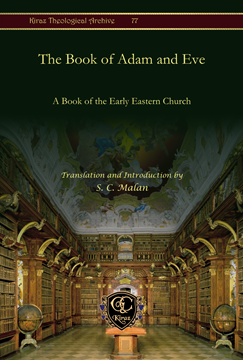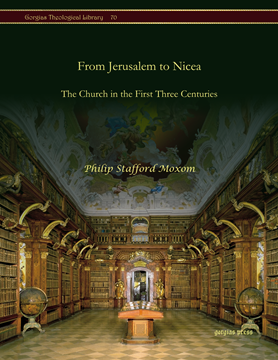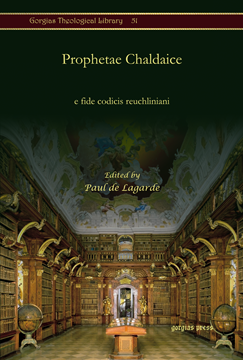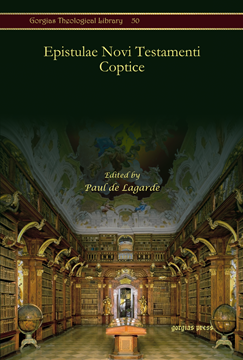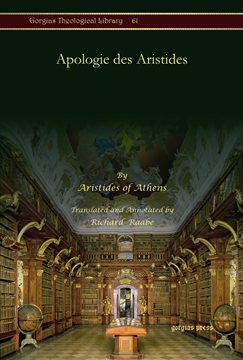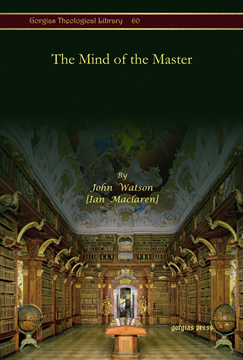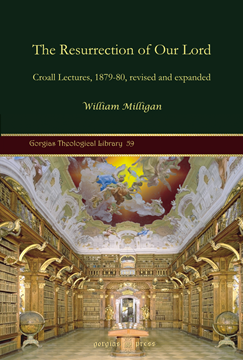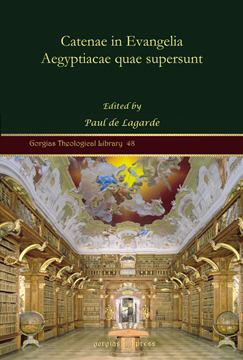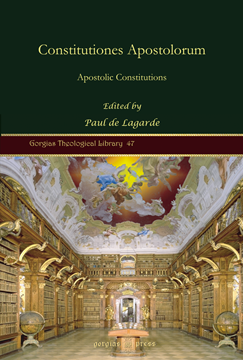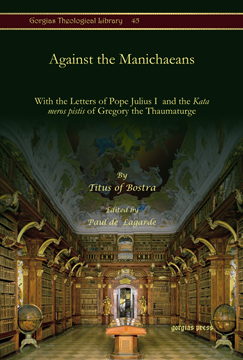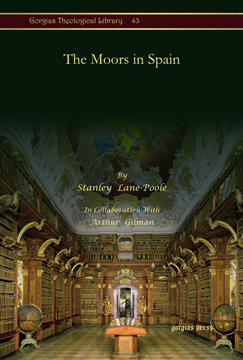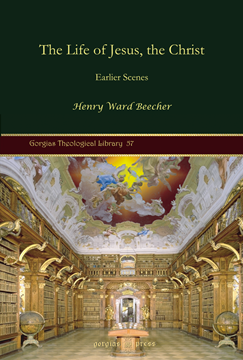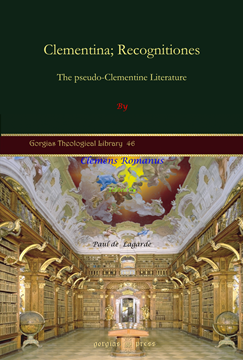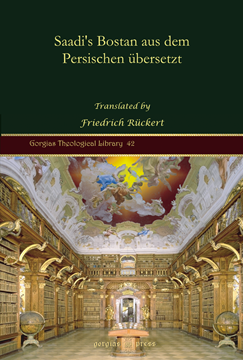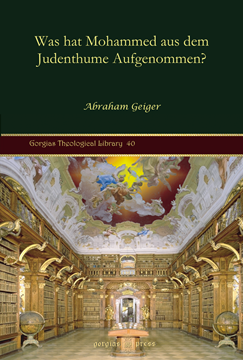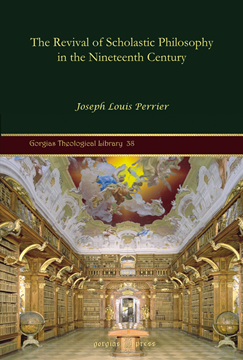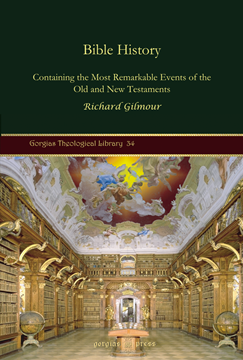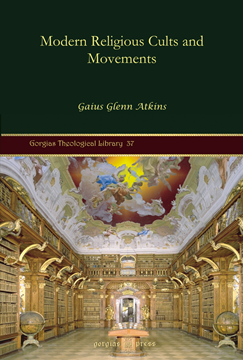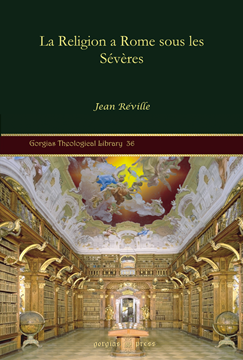Kiraz Theological Archive
The Kiraz Theological Archive brings back to active circulation carefully selected rare classics which are essentials for the shelves of every theological library. The selections include tools for scholars, but also general theological works of interest to general readers.
The Book of Adam and Eve
A Book of the Early Eastern Church
Translation and Introduction by S. C. Malan
Series: Kiraz Theological Archive 77
ISBN: 978-1-61143-830-7
This work narrates the history of the world from Adam to Jesus, presented in an English translation of Ethiopic and Coptic manuscripts. This exclusive translation of rare sources is recommended for readers interested in comparative religion, Oriental Orthodoxy, and biblical studies.
$182.00 (USD) $109.20 (USD)
The Bazaar of Heracleides
Series: Kiraz Theological Archive 75
ISBN: 978-1-61143-472-9
Dialogue by Nestorius, Archbishop of Constantinople, vindicating his theology and his actions; translated from the manuscript of the Syriac translation discovered in 1889.
$219.00 (USD) $131.40 (USD)
The Diatessaron of Tatian
Series: Kiraz Theological Archive 71
ISBN: 978-1-61143-357-9
Samuel Hemphill provides an English translation of the reconstructed text of The Diatessaron using the Arabic translation and Ephrem’s commentary.
$117.00 (USD) $70.20 (USD)
From Jerusalem to Nicea
The Church in the First Three Centuries
Series: Kiraz Theological Archive 70
ISBN: 978-1-61143-354-8
This volume includes the text of the Lowell Lectures delivered by Philip Moxom on various topics in early Christian history.
$196.00 (USD) $117.60 (USD)
Le Mouvement Baptiste
en Palestine et Syrie (150 av. J.-C. - 300 ap. J.-C.)
Series: Kiraz Theological Archive 66
ISBN: 978-1-61719-678-2
This book explores baptism in the ancient world, the sects which practiced it, their history, origins, characters, diversity, and influences.
$202.00 (USD) $121.20 (USD)
L'Hellénisme et l'Apôtre Paul
By C. Toussaint
Series: Kiraz Theological Archive 65
ISBN: 978-1-61719-663-8
This book examines Paul as a hybrid of both Jewish and early Christian traditions meeting at the crossroads of a commonly-shared Hellenistic culture.
$174.00 (USD) $104.40 (USD)
Prophetae Chaldaice
e fide codicis reuchliniani
Edited by Paul de Lagarde
Series: Kiraz Theological Archive 51
ISBN: 978-1-61719-054-4
This eastern Aramaic translation of the Old Testament contains one section of Paul de Lagarde's critical edition of the Babylonian Targum.
$217.00 (USD) $130.20 (USD)
Epistulae Novi Testamenti Coptice
Edited by Paul de Lagarde
Series: Kiraz Theological Archive 50
ISBN: 978-1-61719-048-3
Distinguished biblical scholar Paul de Lagarde provides an annotated Coptic version of the New Testament arranged by the General Epistles, preceding Pauline Epistles, and concluding with Philemon. Titles and references are in Latin.
$154.00 (USD) $92.40 (USD)
Apologie des Aristides
By Aristides of Athens; Translated and Annotated by Richard Raabe
Series: Kiraz Theological Archive 61
ISBN: 978-1-61719-363-7
In this second-century defense of Christianity, Athenian philosopher Aristides explains to the Emperor why the Christian way of worship is the only philosophically adequate one.
$115.00 (USD) $69.00 (USD)
The Mind of the Master
Series: Kiraz Theological Archive 60
ISBN: 978-1-61719-262-3
These fifteen essays by a Presbyterian clergyman are devoted to the personality of Jesus,
$168.00 (USD) $100.80 (USD)
The Resurrection of Our Lord
Croall Lectures, 1879-80, revised and expanded
Series: Kiraz Theological Archive 59
ISBN: 978-1-61719-261-6
The historicity, testimony, and importance of the Resurrection, by the Professor of Theology at Aberdeen.
$167.00 (USD) $100.20 (USD)
Atonement and Personality
Series: Kiraz Theological Archive 58
ISBN: 978-1-61719-260-9
The essential presence of the personality of Christ in the Atonement, by the Regius Professor of Pastoral Theology at Oxford; with a historical sketch of the doctrine.
$193.00 (USD) $115.80 (USD)
System of Christian Theology
By Henry Boynton Smith; Edited by William S. Karr
Series: Kiraz Theological Archive 56
ISBN: 978-1-61719-227-2
Henry Boynton Smith presents a complete manual of Christian theology from the perspective of an anti-Unitarian Congregationalist.
$241.00 (USD) $144.60 (USD)
Catenae in Evangelia Aegyptiacae quae supersunt
Edited by Paul de Lagarde
Series: Kiraz Theological Archive 48
ISBN: 978-1-61719-017-9
Catena on selected passages from the Gospels, from Eusebius of Caesarea and others.
$146.00 (USD) $87.60 (USD)
Constitutiones Apostolorum
Apostolic Constitutions
Edited by Paul de Lagarde
Series: Kiraz Theological Archive 47
ISBN: 978-1-61719-016-2
Apostolic Constitutions, as edited by Paul de Lagarde, who corrects the Greek text extensively from the Syriac, Arabic, Ethiopic and Coptic translations.
$158.00 (USD) $94.80 (USD)
Against the Manichaeans
With the Letters of Pope Julius I and the Kata meros pistis of Gregory the Thaumaturge
By Titus of Bostra; Edited by Paul de Lagarde
Series: Kiraz Theological Archive 45
ISBN: 978-1-61719-010-0
This volume contains the Greek and Syriac versions of the Contra Manicheos by Titus, Bishop of Bostra, as well as the letters of Pope Julius I and a brief expostion of the Christian faith by Gregory the Thaumaturge.
$164.00 (USD) $98.40 (USD)
The Moors in Spain
By Stanley Lane-Poole; In Collaboration With Arthur Gilman
Series: Kiraz Theological Archive 43
ISBN: 978-1-60724-320-5
Taking his interest in the Islamic conquest to its northwestern frontier, Lane-Pool here considers the history of the Moors in Spain. The famous battles and their various outcomes are recorded. A gripping account for students of history, this treatment of the Islamic presence in Europe is a solid piece of research that has stood the test of time.
$160.00 (USD) $96.00 (USD)
The Life of Jesus, the Christ
Earlier Scenes
Series: Kiraz Theological Archive 57
ISBN: 978-1-61719-259-3
This book concentrates on the life and teachings of Jesus, as related by the fashionable Gilded Age clergyman. As a crystallized sample of one sort of Victorian devotion, Beecher's book is full of miracles, scenery and sentiment, but devoid of systematic theology.
$215.00 (USD) $129.00 (USD)
Clementina; Recognitiones
The pseudo-Clementine Literature
By Clemens Romanus; Edited by Paul de Lagarde
Series: Kiraz Theological Archive 46
ISBN: 978-1-61719-015-5
Two chief texts of the pseudo-Clementine literature: the Homilies in Greek, and the Recognitions in Syriac
$184.00 (USD) $110.40 (USD)
Saadi's Bostan aus dem Persischen übersetzt
Translated by Friedrich Rückert
Series: Kiraz Theological Archive 42
ISBN: 978-1-60724-319-9
Considered one of the greatest works of the Sufi writers, Saadi’s Bostan (The Orchard) is an astounding poetic collection of wisdom that includes anecdotes, proverbs, and quotations that engage the rules of life and psychological observations of individual behavior. Saadi (or Abu Muslih bin Abdallah Shirazi, 1184 – 1283/1291?) was a Persian poet and traveler. Here Bostan is presented in German translation, the work of one of Germany’s great poets, Friedrich Rückert, who also had the distinction of being a professor of oriental languages. The lover of medieval poetry will find this supreme accomplishment of Persian poetry irresistible.
$157.00 (USD) $94.20 (USD)
Was hat Mohammed aus dem Judenthume Aufgenommen?
Series: Kiraz Theological Archive 40
ISBN: 978-1-60724-308-3
Undertaking the classic question of the relationship of Islam to Judaism, Geiger begins his treatment with the intertwined questions of what Islam wishes to do, is able to do, and is permitted to do with Judaism. Concepts and opinions such as faith beliefs, moral and legal regulations, and concepts of life are all considered as they moved from Judaism to Islam. A well-regarded early work in the field of comparative religions, Geiger’s work is not to be missed by anyone with an interest in Judaism and its relationship to Islam.
$167.00 (USD) $100.20 (USD)
The Revival of Scholastic Philosophy in the Nineteenth Century
Series: Kiraz Theological Archive 38
ISBN: 978-1-60724-298-7
Written in the period affected by the Neo-Scholastic movement in philosophy, Perrier’s well-known treatment of the subject is still ubiquitously cited. This handy resource lays out the premises of Scholasticism and traces its development up to the author’s time.
$170.00 (USD) $102.00 (USD)
Bible History
Containing the Most Remarkable Events of the Old and New Testaments
Series: Kiraz Theological Archive 34
ISBN: 978-1-60724-278-9
Designed as a primer for Catholic children, this booklet became an historic fixture in American Catholic literature. Dividing the Bible into episodes easily understood by children, the author, Bishop Gilmour, explained in easy language, the Roman Catholic understanding of these stories. Wonderfully illustrated with classic woodcuts, this beguiling book also undertook to introduce the general overlay of church history to young readers.
$190.00 (USD) $114.00 (USD)
Modern Religious Cults and Movements
Series: Kiraz Theological Archive 37
ISBN: 978-1-60724-296-3
A modern classic, Modern Religious Cults and Movements has continued to garner citations even after further investigation has continued to add to the literature on the subject. Atkins begins with the forms and backgrounds of what he considered the inevitable Catholic and Protestant traditions. This portrayal of non-traditional religions in its own day is a period piece that will be of interest to students of American religion and historians of religion in general.
$193.00 (USD) $115.80 (USD)
La Religion a Rome sous les Sévères
By Jean Réville
Series: Kiraz Theological Archive 36
ISBN: 978-1-60724-291-8
La Religion a Rome sous les Sévères is a classic work on third century Roman religion, ranging from the stoicism of Marcus Aurelius to the syncretism of Severus. Reville's knowledge of religion in the late antique world is considerable, and his analysis draws together Eastern mystery cults, Baal worship, and Neopythagorean philosophy as well as classical pagan religion. Yielding lasting results, Reville's study will be welcomed by readers interested in the history of religions.
$160.00 (USD) $96.00 (USD)

